(or orders) in the Coaticook region
Conference: An Historical Talk by Guy Laperrière
Date: Sunday, May 5, 2019
An important subject on local history, concerns the Religious Commun-
ities connected with the Catholic Church.
The subject will therefore, not just focus on the religious community in the city of Coaticook but also, that area between Sherbrooke and the boundary line. The content of this subject will be divided into four sections: The beginnings as portrayed by the second half of the 19th century, the period of greatest growth between 1900 and 1940, following the period from 1940 to 1970 and, finally, from 1970 until the present day.
1. The second half of the 19th century:
The first religious order to estalish itself in the area was the
Congregation de Notre Dame which founded Mont Notre Dame, in
Sherbrooke in the year1857. This religious community was the first
order founded in Canada by Marguerite Bourgeoys in Montreal in the
year1659. The role of this religious community was the education of
young girls. Unlike the convents of the time (like the Ursulines), which
were cloistered, Marguerite Bourgeoys, who was canonized in 1982,
dreamed of replacating ''The Travelling Life of the Virgin Mary''. These
Sisters lived in convents all over Quebec without being cloistered. They
arrived in Sherbrooke in 1852.
The Abbot, Jean-Baptiste Chartier became a priest and arrived in Coati-
cook in 1868.He was the first priest for the new parish of St. Edmond.
Coaticook, like Sherbrooke, was part of the diocese of St. Hyacinth
which had been founded in 1852. One of Chartier's primary concerns, as
was also the concerns for many of the priests at this time, was the edu-
cation of children especially to keep them out of the Protestant school
system. He wanted to build a convent so met with the best known order
which was the Congregation de Notre-Dame. He asked them to under-
take the costs of the construction. This was in 1869: the Sisters refused.
He requested the assistance of his bishop in St. Hyacinth and through
him received the services of the Sisters of the Presentation of Mary,
the convent was built at their expense: It was a handsome granite build-
ing of two stories in height, today still one of the nicest buildings in Coat-
icook. Who were the Sisters of the Presentation of Mary? These were
nuns trained to teach who came from the south-eastern part of France.
This order was founded on November 21, 1796, the feast day of the
Presentation of the Virgin Mary. They arrived in Quebec in 1853, having
been recruited in France by His Grace Mgr Prince, the first bishop St.
Hyacinth, starting in1852. They had well known convents for girls in St.
Hyacinth, Drummondville and, Coaticook.
It was on September 15, 1870 that three Sisters arrived in Coaticook:
the 150th anniversary of this arrival was celebrated in 2020. There
were also clashes between Catholics and Protestants during this era. For
example, on November 17, 1870, Protestant children threw snowballs
at the Sisters who were out on a walk; the Anglican minister had the par-
ents of the children sign a letter of apology. As for the Sisters, this was
the proof of Protestant fanaticism.
In 1871, there were 20 boarders at the convent, 30 part time
boarders and 60 day students under the direction of the school com-
mission. At this time, as we also see today, were both private and pub-
lic schools. The school commission was in charge of the public school:
this was the day school. The Convent, with the boarders, was a paying
concern. These students came from families who were more well off. It
was often seen that the school commission was not too forthcoming
with paying expenses that the nuns used the funds from the boarders-
and, for example, the music lessons - to foot the bill for the public
school, those poor little girls. In 1874, the commissioners bought a
house in front of the Convent for the day students.
There was some dark moments in 1875: an economic crisis and the Rev.
Chartier was forced into bankruptsy. Unfortunately, it was the Trust and
Loan who rented the Convent to the Sisters for $200.00 per year. The
Sisters paid the rent with a $200.00 subvention from the government.
In 1878, with no improvement in the situation, the Sisters announced
that they would be leaving. The people united: by petition, written dona-
tions, bazaars. It was due to this effort that 5 years later, in 1883, that
the sisters bought the Convent with the following stipulation in the con-
tract: At that time when the Sisters could no longer teach the children or
run the boarding school, they would be obliged to hand over the Con-
vent with all the contents and improvements into the hands of the St.
Edmond de Coaticook parish association. This sheds a light on what par-
ticularly took place when the Sisters turned over the Convent as a gift
to the College Rivier in 2014: "In the event that the Sisters could no
longer teach and run the boarding school, they would be obligated to
to hand over the Convent with the contents and improvements to the
St. Edmond de Coaticook parish association".
In 1891, a statistical review in Coaticook indicated that the population
of Catholics was 3086 persons, constituting 60% of the population and,
the Convent consisted of the following grouping: 10 Sisters, 282 stu-
dents of which 45 were boarders, 72 part time boarders, and 163 day
students.
Continuing in the area of education just one year after the opening
of the Convent in Coaticook, two Gray Nuns from St. Hyacinth arrived
in St. Venant de Paquette. They were invited by the Rev. Louis-Salomon
Lambert and he wanted them to teach and visit with the sick. They
opened classes and registered 26 students, boys and girls. Everyone
was very pleased with the situation but in 1875, by order of the Bishop they
were recalled and had to leave the village to the great regret of the
priest.
One year later, Abbot Jean-Baptiste Champeau succeeded in Sisters
coming to Saint Venant, les Filles de Ste-Anne, known later as the
Sisters of Ste-Anne. This order was founded in 1850 by Esther Blondin
with the following goal: "education of needy children, both boys and
girls". The Mother House was located in Lachine. In 1878, the Sisters
constructed a new Convent. The situation was not an easy thing. After
one visit, the Mother Superior wrote, "They are all very poor with few
necessities but they seem very happy". Quite a distance from this area
they were called the Missionaries of the Mountains and were recorded
as having, "five or six dwellings with a church constituted the make up
of the village.
There were too few students: in 1881, 37 boarders, day students:
16 girls, 26 boys. In 1884, due to the isolation of the sisters, the lack of
resources, and the increase in debt, the superior general told Mr. Racine
that the Sisters would be withdrawn, stating "the impossibility of con-
tinuing the work, which moreover, did not receive the encouragement
and support from the parishioners one might expect". The Bishop was
in agreement: There were not enough funds to sustain the establish-
ment.
Do you think that Saint Venant would let this situation take place? This
same year, 1884, the Rev. Louis-Mederic Hamelin, wanting to continue
in the in educational studies, approaches another order, the Sisters of the Assumption of the Blessed Virgin, an order founded in 1853 and established at Nicolet. The purpose of their work was in the area of Christian education of young girls and especially the poor girls from the
towns, the villages and from the countryside. However, it must be seen
that requests were increasing: 1884, 1885, 1886. Finally, the Sisters
were agreeable to come to St. Venant in 1887. The Rev. Champeau gave
them the Convent , with the idea in mind that of opening a boarding
school for young girls and a day school for little girls and boys. Five
sisters arrived on August 23, 1887 and named the Convent "The Paque-
ville Convent". The conditions at the beginning were very difficult: the
Sisters canvased the area for donations and they received just about
anything in return for their troubles, even live hens. The priest was very
satisfied with their efforts. The Sisters remained in Saint-Venant until
1964. Their were also Sisters in Sainte-Edwidge.
As always for the education of girls, after Coaticook and Saint Venant,
a third Convent was built in Stanstead. It was the Rev. Michel McAuley,
born in Ireland, ordained a priest in St. Hyacinth, priest in Granby from
1860-1868 then in Stanstead 1868-1883 before becoming a priest in
Coaticook from 1883 to 1902, who had made the requests to the Sisters of the Congregation of Notre Dame.
In 1874, the Sisters bought a house with its
accompanyments for $4000.00 of which half was paid for by the Rev.
Mr. McAuley. As such, the Sisters of the Presentation of Notre-Dame
arrived in Coaticook in 1870, 1871 in Saint Venant and 1874 in Stan-
stead. The school in Stanstead opened in 1875, with three Sisters arri-
ving to open two classes in English. One year later, in 1876, another
Sister arrived and started up a class in French. The Convent was able to
enroll about twenty boarders.
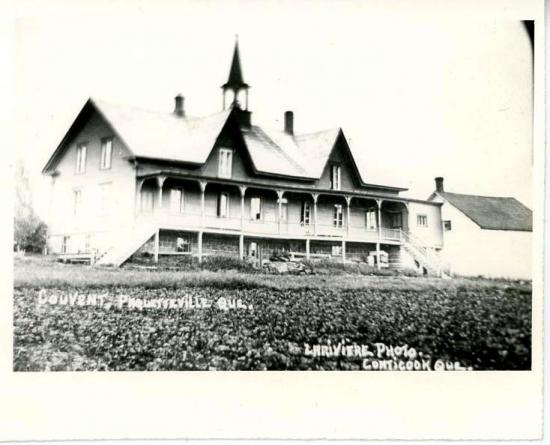
The Paquetteville Convent was situated at St-Venant de Paquette
Unfortunately, one year later, on October 3, 1877, everything
burned. The Sisters and the students were housed in Sherbrooke at
Mont Notre-Dame. The insurance paid $3, 500.00 in damages. The
priest and the parishioners did everything they could to keep the
Sisters in this area but the authorities of the congregation decided to
close the establishment. The Sisters never came back to Stanstead
which was too bad as the attendance at the school was good, 84 stu-
dents in 1877.
Great changes are taking place in the religious world in the region.
Since 1852, the Catholic center in Sherbrooke, Coaticook or Stanstead
came under the new bishopric in St. Hyacinth with radical changes
taking place in 1874, with the creation of a new diocese in Sherbrooke
and the nomination of the new Bishop Antoine Racine. Until this time he
had held the the position of priest in Quebec. Therefore, it would now be
the jurisdiction of Sherbrooke that would make the decisions concern-
ing the religious community in the region. His Grace Mgr Antoine Racine
would take inspiration from his brother, His Grace Mgr Dominque
Racine, Bishop of Chicoutimi, who succeeded in welcoming a group of
Ursuline Sisters from Quebec who opened a Convent in Roberval. In
1882, the Rev. McAuley found a piece of land and went to Quebec to
urge the Sisters to buy the land and to obtain the authorization from the
Archbishop of Quebec, His Grace Mgr Taschereau. In 1883, McAuley
became the priest in Coaticook and the work on building the Convent in
Stanstead was begun. In 1884, His Grace Mgr Racine presented the bell
to the monastery and also helped to open the boarding school and day
school with 157 students, Catholic and Protestant. In this area it was
left to the Sisters to develop the importance of religion and education
and to make known the French language, a language almost ignored in
the region.
What about the education of boys? The Brothers of the Sacred Heart
would come to this region to insure that boys would get an education. In
effect, the secular clergy would concentrate on the college classics and a
good liberal education. The Bothers would spend more time with the
craft and trade side of education. The Brothers of the Sacred Heart
came to Sherbrooke in 1882. Six Brothers came to teach the boys
schools in the town. From this time, foundations were built in Richmond,
and several other towns in the region and one was opened in Coaticook
in 1890. The Brother chosen to establish a foundation in Coaticook was
Brother Francis, an American, who had come to Arthabascaville in 1874
to teach English and singing. At the school's opening in 1890, the school
consisted of 5 grades and 168 students. At first it was a Commercial
Academy but very quickly it changed that name to become the Sacred
Heart Academy. In 1936 the name was changed again to become the
Brother of the Sacred Heart. This was the most important order of
Brothers teaching in the Eastern Townships.
They were here for the general education of young people but there
were other students needing an education: the sick, the poor,
orphans, the elderly and the need for health and social services. In this
area, it was this community who saw to all of this. Nominated to the task
were the Sisters of Charity (or the Gray Nuns) of St. Hyacinth. They
were in St. Venant from 1871 to 1875, then were withdrawn from
there by both the Bishopric (of St. Hyacinth and Sherbrooke) because
teaching was not part of their vocation. It should be explained, that in
Quebec between 1850 and 1950, that the bishop of each diocese acted,
for all practical purposes, as the ministry of health, education and social
services with the advantage that these services were decentralized since
they were present in each diocese. It was why, in 1875, that Sherbrooke
set up the diocesan seminary known as the Charles Barromee Seminary.
In the same year, 1875, the Sisters of Charity came from St. Hyacinth a
branch of the Montreal Gray Nuns, went on to found the Sherbrooke
Sacred Heart Hospice Care Center. In 1891, this hospice ( known today
the Youville Pavillion) which consisted of 78 needy persons, 47 orphans
and 8 boarders. In time the Sisters opened in 1909, St. Vincent de Paul
Hospital, which included in 1911, 25 Sisters, 35 patients, 5 boarders
and 16 maids. Two other orders were established in Sherbrooke in
1895. First of all, a contemplative order of piety, Les Soeurs adoratrice
du Precieux-Sang, also founded in St. Hyacinth in 1861 by Aurelie
Caouette. The Convent on Dufferin St. in Sherbrooke had been built in
1912. Another order would come to be established in 1895 was Les
Petites Soeurs de la Sainte-Famille, retained in service of the clergy.
This order was founded in New Brunswick by Mother Marie-Leonie who
transferred the Mother House to Sherbrooke in 1895, at the request of
His Grace Mgr LaRoque. These Sisters saw to the household needs and
maintenance of the clergy, in the bishop's quarters and in the seminar-
ies. In each of the larger colleges or seminaries, there would be between
20 to 30 Sisters taking care of the kitchen, the laundry and the house-
work. In 1930, a new Mother House was built on Galt St., a large house
visible from the Jacque-Cartier Bridge in Sherbrooke.
2. The Twentieth Century, 1900-1940
Let us review what follows over the coming years. In the phone book
of 1933, we see that the Gray Nuns had 54 Sisters at the Sacred Heart
Hospice and 60 more at the general hospital known as St. Vincent de
Paul. Again in 1933 the Sisters of the Presentation of Mary listed 44
Sisters in their Convent at St. Edmond and 6 more at l'ecole Saint-Marc.
The Convent in Stanhope had 16 Sisters, Compton had 9 and there
were 4 in St. Hermenegilde. It was during the 1930's that the recruit-
ment for Sisters was at the highest, proprotional to the population.
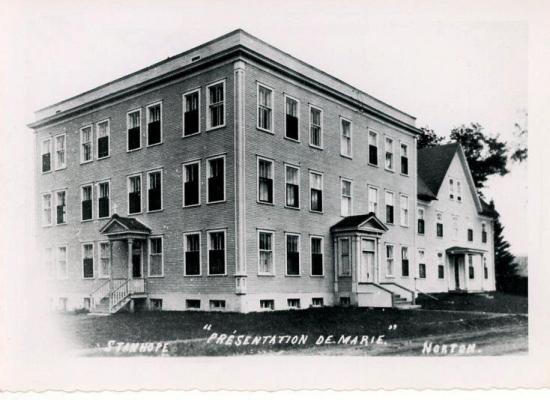
The Stanhope Convent was siuated in Stanhope
Other orders came about in the dioceses. Let us note that Les Soeurs
des Saints-Noms de Jesus et de Marie were established in Disraeli in
1898. The Ladies of Charity of the Sacred Heart of Jesus came to New-
port, Vt. in 1905. As well, in Magog in 1907, they opened a nursery to
take care of the children of the workers who worked in the cotton mills.
They furnished education for the region, in Magog, Martinville,
Waterville, Rock-Island, St. Malo, and St. Isidore. In 1921, they were
put in charge of the Hotel Dieu Hospital in Sherbrooke.
There were also anglophone orders of Sisters at that time. In 1910, an
order of Presentation Brothers arrived at St. Patrick's School in Sher-
brooke. Another order of men were established in 1913, the Redemp-
tionists in the parish of Notre-Dame du Perpetual-Secours in
Sherbrooke. They would promote, among other things, private retreats
at Villa Saint-Alphonse, starting in the 1920's.
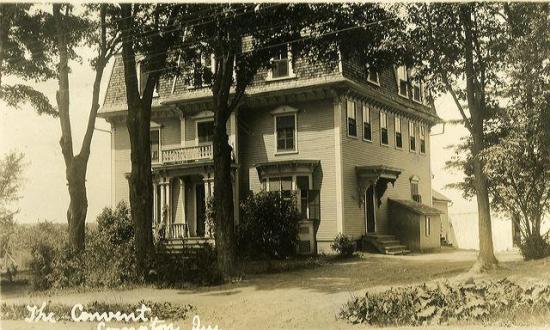
The Compton Convent was situated on Hathley Street
Other important religious orders would be set up during the 1920's:
orders of missionaries. In 1919, the Soeurs Missionaries de Notre-
Dame des Anges was established in Lennoxville. They would be assigned
to missionary work in China. The next year, 1920 came with the nearby
establishment of the novitiate of the Franciscans. Notre-Dame des
Anges was a Franciscan devotional order.
Another order was established in the area in 1902. It was known as
the Missionaries de la Salette. This order arrived in Stanstead in 1902
and stayed there until 1916. It was His Grace Mgr Laroque, the second
Bishop of Sherbrooke, who asked for them to go to Stanstead to take
charge of the Stanstead parish, the Ursuline Convent and the parish
school for boys. And, if they were able to convert a certain number of
Protestants, so much the better. They were able to get the Brothers of
the Sacred Heart who would take charge of the boy's school from 1903
to 1914. The Bishop was very satisfied with this situation.
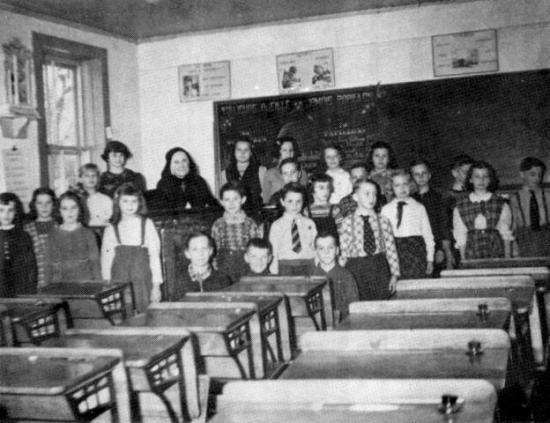
Class of students at Compton Convent
Stanstead, however, was not a big enough place to support these
religious teachers. The Rev. Cruveiller from Stanstead complained, that
in 1904, there were only three orders for 200 Catholics and the compe-
tition was strong from the Benedictines. The Benedictines were then
transferred to St.-Benoit-du lac in 1912. The Benedictines would come to
Stanstead to preach and to try and recruit the faithful. In 1914, the
Benedictine and the Salettins ( this is the current name of the Mission-
aires de la Salette) would be engaged in a battle of wills over the parish-
oners. Les Missionaries de la Salette would leave Stanstead in 1916.
They left a large impression in the area, enough so that His Grace Mgr
Desranleau named the new church in Baldwin, Notre-Dame de la
Salette in 1947 to show tribute to the Fathers of the Salette who served
in the Sacred Heart Parish in Stanstead from 1902 until 1918.
3. The Twentieth Centurey, 1940-1970
This was a period of economic growth, a boom period particularly in
the area of education. What was of particular importance was the large
number of secondary schools which were opened for boys. Three new
orders were within the area of Sherbrooke: in 1947, the Mariannhill
Missionaries who founded Mt. St. Anne, in 1948, les Servites de
Marie opened the college in Ayer's Cliff known as Notre-Dame des Ser-
vites, and les Salesiens de Don Bosco, who inaugurated the Salesian
Seminary in 1962. As well, we can add the Brothers of the Sacred
Heart, who built an important complex in 1963 at Bromptonville. These
four buildings have now become private seconday schools, but this is
not all their main concern to the students. This was before all the semin-
aries, to offer a place for religious vocation for the con-
cerned congregations. In the same context, we must mention the no-
viciate of Freres des Ecoles Chretiennes, which opened in Compton in
1948: it was St. Michel House which taught until 1968.
Les Servites de Ayer's Cliff revealed that they needed to open a
college in Quebec for religious study.The Servites, an order founded in
Italy in the 13th century, was to open a branch in Montreal in 1912 to
serve the Italian community. They first had wanted to acquire Ross
College, the name of what is known today as Bishop's College School
in Lennoxville in 1946. But His Grace Mgr Desranleau prevented this
purchase as he wanted both that college and Bishop's University to
make into the University of Sherbrooke. The Servites also turned down
the offer of a nice property, White Gables Farm in Ayer's Cliff, which
bordered on Lake Massawippi. They bought and transferred in 1948
St. Alexis Seminary which is located in Ottawa. They built the college,
with 75 places: the first five grades consisted of classical studies. In
1961, it was enlarged and a new college built which was capable of
housing 200 boarders. The old college became a home for religious
persons. Until 1980, it was strickly servite work which allowed to
recruit students for many vocations.
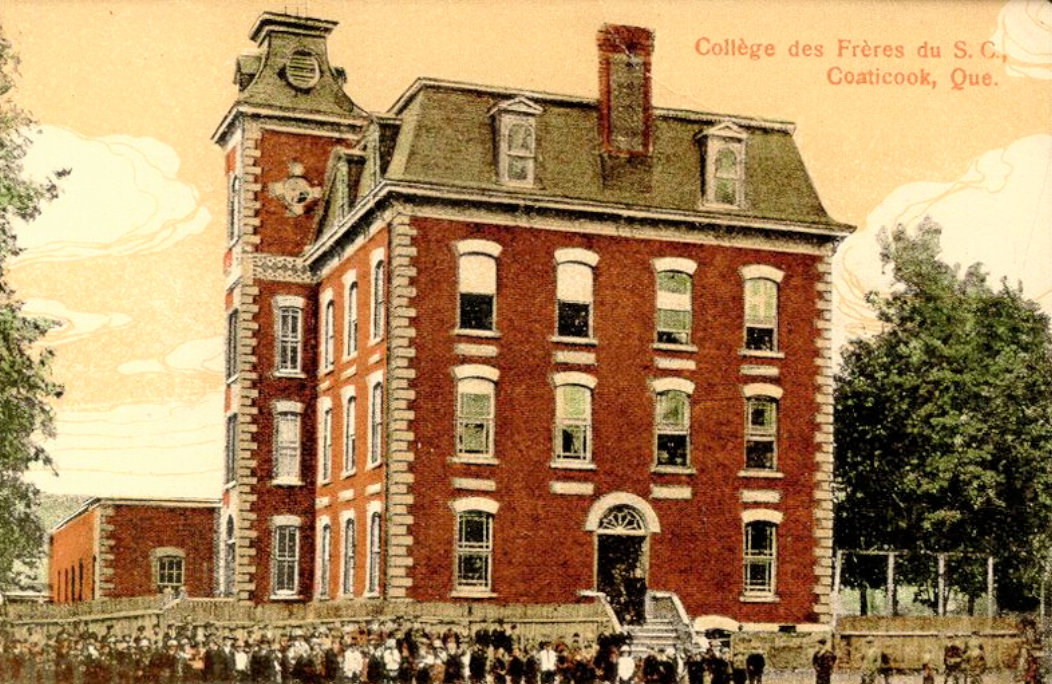
The Sacré-Coeur School during its construction
Continuing in education, and in order of the Brothers of the Sacred
Heart, this time, it should be quite strongly mentionned the action of
Brother Theode, between 1944 and 1954. In 1944, he was the head of
the 12th grade students at the Sacred Heart High School in Sherbrooke,
who regrouped all the secondary students together from the city. He
wanted all these students to go on to university. He drew up a program
for a 13th grade which would allow the students access to University
admission. He also set up a foundation to take into account financial
aide for the students. In 1950, the initiative came from Abbot Achille
Larouche, priest in Waterville from 1957 to 1985. The Sisters bought
the Royce L. Gale property in 1963, a boarding school for 20 students
enrolled in the eighth grade. In the following year they built a boarding
house and a provisional house: This would become the Boarding House
for the Sisters of the Sacred Heart of Mary, which opened in 1964 and
was capable of accomodating 150 female boarders and 50 day students.
In 1968, the boarding house took the name of the Francois Delaplace
College, after the father of the french Holy Spirit who had founded the
order in Paris in 1862. This was actually a private secondary school for
girls which catered to about a hundred student boarders and day stu-
dents.
In Waterville, at this time, an Orphanage was established. It was known
as the St. Joseph Orphanage and run by the Freres de Sainte-Croix, who
had arrived in the diocese in 1942 and started up the orphanage in
1946. This place would house many different vocations. In 1961 it
became the Val Estrie College, an educational school and an institution
studying agronomy. In 1968, it was a center for physical education for
problem youth. In 1981, a new vocation: the Val-Estrie Center an out-
door activity center for anyone who wished to participate. It was always
the Brothers of St. Croix who took care of the facility.
In 1985, it became a family vacation site and in 1990, a vacation camp
for children 4 to 12 years of age, and it had a capacity to hold 220 per-
sons.
It must be added that in 1948 to 1953, an order of nuns had supplied
material services to the orphanage. They were known as the Soeurs Dis-
ciples du Divin Maitre. Waterville also welcomed between 1991 to
1997, Soeurs du Precieux-Sang who established their monastery on the
Val Estrie site. They would later move back to the Mother House in St.
Hyacinth.
Let us now have a look at those hospital orders who furnished the employ-
ees. Since 1951, the Coaticook Hospital was graciously attended to by
the order of Sisters known as The Sisters of Charity of St. Vincent de
Paul. This was a large French order founded by Vincent de Paul himself
and Louise de Marillac, in 1633 in Paris. They were to administer to the
needs of the poor and the sick. In Coaticook we return to the year 1947.
The town wanted a hospital and Premier Duplessis stated that there
would be no hospital without the presence of nuns. Les Filles de la Char-
ite de Saint-Vincent de Paul were administrating the St. Luke Hospital in
Asbestos.They agreed to come to Coaticook and arrived in 1951 and in-
augurated the Ste. Catherine-Laboure Hospital, in the name of the
Sister of this order who had seen an apparition of the Virgin Mary, on
rue Bac, in Paris, in 1830. Catherine Laboure was canonized in 1947.
These nuns would remain at this hospital until 1970 opening several
different services: a hospital center, a nursing school for auxillary
nurses, a volunteer action center, a second-hand clothing shop, meals
on wheels, family kitchens, services to the poor. They would leave the
city in 2007.
With the departure of the Soeurs de la Charite de Saint-Hyacinthe in
1970, the Sisters of Charity in St. Hyacinth, who had been in Sher-
brooke, took over the work at the St. Cathering Laboure Hospital until
1987.
Another responsibility of the orders was to the places of pilgrimage. The
most well know place in the area was that at Beauvoir, dedicated to the
Sacred Heart. In 1943, His Grace Mgr Duranleau wanted to make an im-
portant place so established les Filles de la Charite du Sacre-Coeur. A
bigger church was built in 1945 and in 1948, Assomptionists took care
of the sanctuary. They would care for this site until 1996 when the
Marist Fathers took over.
It is therefore important to state, the varying amount of work that was
done by the orders was important and wide ranging: educational, social,
medical (hospital), and the Sisters.
4. 1970 Until Today
Since 1970 great changes in society have taken place. The seculariza-
tion of society took place over a number of years. The secularization
took place with both people and institutions. Many priests, nuns, and
other religious persons returned to a more regular life. The government
took over the control of schools and hospitals and orphanages as well
the social services. Traditional colleges gave way to comprehensive
schools and to the Cegeps, regular schools and some vocational schools
began to disappear. Many of the Brothers and Sisters were called upon
to do other things, and recruitment became increasingly rare. Some of
the Brothers and the Sisters would rededicate themselves to a new
calling, for example, Brother Edmond Therriault, one of the Brothers of
the Sacred Heart, would go on to administer for another 25 years. He
would become the Director General and the director of other projects at
the Head Office of the Coaticook School Commission until his retirement
in 1995.
The renewal of orders is very rare. An example known in our area would
be that of the Famille Marie-Jeunesse. This order brought together the
youth, men, women, and couples, was born in Sillery in 1986, and
established itself in Sherbrooke in 1990. She was able to get the Sister
House of the Presentation of Mary, Conseil St. in Sherbrooke.
In general, the Eastern Townships was more tolerant to the seculariza-
tion movement than were other areas of the province: the private
colleges were maintained , the Beauvoir Sanctuary also was saved, and
the Benedictines of St. Benoit du lac. There seemed to be a movement of
mutual aid between the orders: many ended up in retirement homes.
The archives of four important orders of the area can be found at the
Centre d'Archives Mgr Antoine Racine, in the basement of the cathe-
dral, restored and inaguraged in 2016. In addition to the archives of the
archbishop and that of the Seminary, which houses the archives of the
Petites Soeurs de la Saint-Famille, des Filles de la Charite du Sacre-Coeur
de Jesus, the missionary Sisters of Notre-Dame des anges and the Bro-
thers of the Sacred Heart.
This ends a review of the different orders in our region. We are now able
to see the contribution of these orders to society and the changes
related to the different levels of society, throughout the years.
In Coaticook, the comprehensive school known as La Frontaliere, the
Albert l'Heureux School was documented in the ''Courant'' in 2019,
Number 21 and the Rivier College of Coaticook, the Pensionat, was
written up in the ''Courant'' of 2021, Number 23. These write ups are
very useful for research and knowledge.



